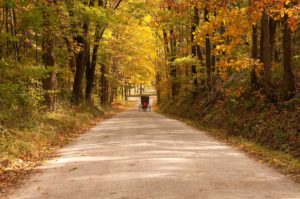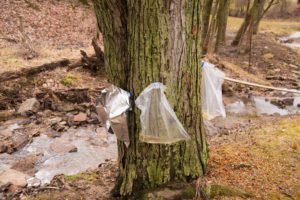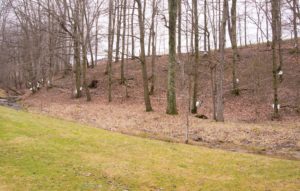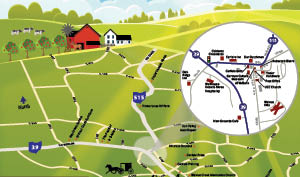It's February and even though you can't see it, the trees are waking up and spring is not far away. Here in northeastern Ohio, February is a busy time for those who produce the that delicious elixir of spring – maple syrup.
Once the sweetener of the pioneer and the poor farmer, maple syrup is now a delicacy for chefs across the United States. It's used not just on your pancakes, but in pies, cookies and even meat marinades.
Here is Ohio's Amish Country, we are blessed to have woods chock full of the Sugar Maple trees, the species that produces sap with the highest concentration of sugar. By the way, they're also some of the most colorful trees you'll see during our beautiful autumn leaf season.
And there are plenty of maple producers in the Walnut Creek area, too. In the bare woods of winter, it's easy to spot trees that are tapped. You'll see buckets, bags, even complex tubing systems to collect that precious liquid that will eventually become the amber colored syrup for your table.
How maple syrup is made
To collect the sugar-containing sap of maple trees, they must be "tapped." A small hole is drilled through the bark to the xylem of the tree. The xylem is the transport structure of the tree that brings water and nutrients from the roots to the branches and leaves. Depending on the size of the tree, multiple taps can be made. And no, it doesn't hurt the tree to tap it, but it can harm the value of the tree for lumber.
In late winter, maple trees begin moving sap from the roots to wake the tree up to produce buds and then leaves. The first sap to "start running" is the most useful sap. Cold nights and warm (but not too warm) days cause the tree to pump sap at a faster pace. Generally, sap will run best when the daytime temperatures are in the 40’s with the night-time temperature goes into the twenties. When the weather gets too warm, the sap will become cloudy and bitter, ending the boiling season.
The traditional way of collecting sap (and my grandpa's way) was to firmly insert a "spile" into the tree, a hollow metal tube which then drained into a bucket that hung on the spile. Once the sap had collected, grandpa would drive the horses and sled through the woods to dump each bucket into a barrel or container. He'd then bring the full container back to the "Sugar Shanty" to boil the sap in a kettle over a wood wire to cook off the water. As the water boiled away, the sap became more concentrated and eventually turned to syrup.
During World War II, this was how grandpa provided his family with sweetener since sugar was rationed.
Labor intensive
Boiling maple syrup develops character in two ways – hard work and patience!
Because the concentration of sugar in the sap is low (2 to 5%), it takes approximately 30 to 40 gallons of maple sap to produce a gallon of syrup. That means long days (and nights) in the sugar house to keep the fire burning and the syrup boiling.
My own father got the bug to start boiling maple syrup after helping grandpa years ago. Dad built a small “sugar shack” behind our barn and installed equipment built for boiling syrup. The shack had a wood furnace with a large flat top, built to hold an evaporator pan. Ours was about three feet wide and six feet long (but they can be much larger) and was divided into three compartments.
The large back compartment was built with flues, or v-shaped ridges on the floor of the pan. Flues add more surface area to the pan and make the sap cook faster. The front two compartments had flat floors and were made for finishing the syrup. Each compartment had a spout in order to run each batch between the compartments, as well as a harvesting spout for removing the finished syrup.
Each morning, Dad got up around 4am to start the fire burning and get the sap boiling. We used wood from our own woods to boil so every piece needed to be cut and split. Splitting wood by hand has two purposes: keeping warm on a chilly day and keeping the boredom at bay.
The evaporator pan had to be watched at all times to keep the syrup from burning. Late at night, Dad would come in with the day’s harvest – a few of gallons of syrup. Mom would then can syrup in quart jars and it kept fresh for use all year long.
Believe me, there is no better taste than fresh warm maple syrup over your pancakes, waffles or french toast. It even makes plain oatmeal tolerable!
The Modern Way
Recently I visited the operation of Nathan Mast and family, a local Amish family in Walnut Creek township. They boil syrup on a commercial level, producing about 1,000 gallons of syrup per year (calculate how much sap they handle!). Their "sugar shanty" houses several large capacity holding tanks, the largest holding 3,000 gallons of sap.
Before boiling they will run their sap through a Reverse Osmosis System. The sap is pushed through a semi-permeable membrane in which only water molecules may pass through. This would be similar to water purification, but in reverse. In this way, the sugar water is concentrated before entering the boiling system.
The concentrated sap now passes through to the evaporator pan to finally be boiled in to delicious syrup. This process may now only take two to three hours instead of all day! Isn't technology wonderful!
Give it a try?
Want to try making syrup yourself? Lehman's Hardware in Kidron, Ohio has kits for backyard producers, including spiles, bags and instructions.
It's certainly not hard, but be aware that you will need to boil and boil and boil. Then, you will boil some more! It will produce a lot of moisture in your kitchen so be sure to turn on your vent fan to pull the moisture out.
Insider tip from my dear old Dad: the sap will easily boil over if you don't watch the pan. To prevent this, drop a sliver of butter into the boiling sap. The fat in the butter keeps the pan from foaming and boiling over, plus, it doesn't hurt the taste of the finished syrup.
Where to buy locally-made Maple Syrup
Nathan Mast's syrup can be purchased at both Walnut Creek Cheese as well as Hillcrest Orchard in Walnut Creek. Try some and know that you've purchased a delicious, natural product straight from nature's bounty in Ohio's Amish Country!





